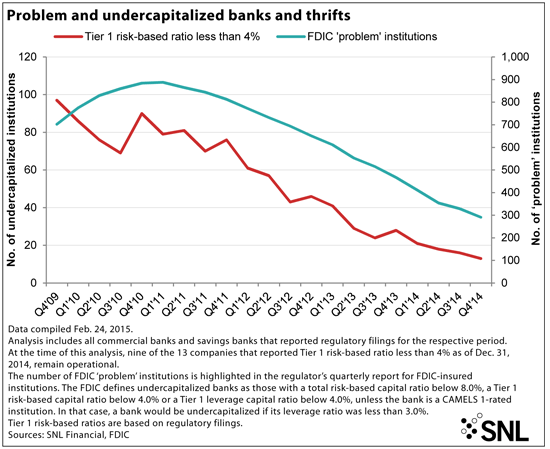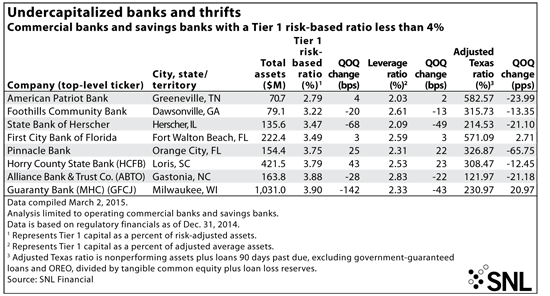Thin wallets less frequent
SNL Report: Undercapitalized ranks thin, some banks escape through sales
- |
- Written by SNL Financial

By Hina Nawaz and Nathan Stovall, SNL Financial staff writers
The number of undercapitalized banks fell considerably in 2014 and a handful of institutions managed to escape negative territory by finding a lifeline in the form of a partnering institution.
State of industry capital
FDIC defines undercapitalized banks as those with a total risk-based capital ratio below 8.0%, a Tier 1 risk-based capital ratio below 4.0%, or a Tier 1 leverage capital ratio below 4.0%, unless the bank is a CAMELS 1-rated institution. In that case, a bank would be undercapitalized if its leverage ratio was less than 3.0%. If the Tier 1 leverage ratio at any bank falls below 2%, FDIC would usually be required to step in within 90 days.
No institutions had a leverage ratio below 2% at the end of the fourth quarter. Thirteen banks and thrifts were undercapitalized at the end of the period, based on the criteria of having Tier 1 ratios below 4%, compared to 16 institutions at the end of the third quarter of 2014 and 24 institutions a year prior, according to SNL data.
After a significant decline in the first three months of 2014, the number of undercapitalized institutions decreased at a more moderate pace in the last nine months of the year, in part due to the relatively small size of banks remaining in that territory.
Still, three banks joined the undercapitalized ranks in the fourth quarter, four banks moved into that territory in the third quarter, five institutions became undercapitalized in the second quarter, and six institutions joined the group in the first quarter of 2014.
Few banks find themselves in dire straits as the health of the industry continues to improve. Such is evident by the consistent declines in the FDIC's "problem list," which by the end of the fourth quarter had fallen to the lowest level since year-end 2008. The number of institutions on the problem list decreased to 291 from 329 in the third quarter and 411 a year prior, an 11.6% drop from the linked quarter and down 29.2% from the year prior. Problem banks' assets fell to $87 billion at the end of 2014, the first time the group has fallen below that level since the second quarter of 2008.
Before the credit crisis fully erupted, the number of problem institutions stood at 171 at the end of the third quarter of 2008. Problem institutions hit their high point in the first quarter of 2011 at 888, when bank failures were near their peak. Problem banks' assets peaked a year earlier, totaling $431 billion at the time.
Failures were the main contributor to the decrease in undercapitalized institutions in 2011 and 2012. The trend was consistent through those two years, when the number of undercapitalized banks decreased by 49 to 44 institutions. During that period, a number of banks joined the ranks of the undercapitalized and 143 banks failed, while 36 banks found their way out of trouble through recapitalizations, mergers or balance sheet shrinkage and de-risking, coupled with modest earnings in some cases.
The trend was more positive in 2013, when 16 banks, including five in the fourth quarter, found their way out of undercapitalized territory without failing or closing their doors. Just 24 banks failed in 2013—only two banks failed in the fourth quarter.
The pace of failures was even slower in 2014. Four banks failed in the fourth quarter of 2014, bringing the total to 18 failures for the year, the lowest level since before the credit crisis. Four banks previously deemed undercapitalized have failed since SNL last published the list of undercapitalized banks in the industry. By far, the largest of those institutions to fail was Doral Bank, which closed its doors on Feb. 27, just days after being deemed "critically undercapitalized" by the FDIC. The San Juan, Puerto Rico-based bank moved into undercapitalized territory in the third quarter after battling asset quality issues and consecutive losses over the last five years.
 For a larger version, click on the image.
For a larger version, click on the image.
When excluding banks that have failed or merged since the end of the fourth quarter, SNL data shows that, as of March 2, eight banks were undercapitalized based on Dec. 31 data, compared to 13 banks at the last publication of the list of undercapitalized banks.
The eight undercapitalized banks reported a median Tier 1 ratio of 3.62%, up from 3.16% at the end of the third quarter. Still, with turnover occurring in the group, the banks currently in undercapitalized territory experienced a median linked-quarter decrease in their capital ratios of 8.5 basis points.
Getting out from under
Five banks escaped undercapitalized territory during the fourth quarter, compared to five in the third quarter, six in the second quarter and four in the first quarter of 2014. Three banks previously deemed undercapitalized failed after the fourth quarter ended, but four banks escaped undercapitalized territory through positive means.
Two of those institutions had reported negative Tier 1 risk-based ratios and negative leverage ratios at the end of the third quarter, but closed the year in positive territory. The two banks—Fayette County Bank and Winfield Community Ban —were not considered undercapitalized at the end of the second quarter, according to SNL data.
Fayette County Bank reported a Tier 1 risk-based ratio of 10.83% and a leverage ratio of 7.74% at the end of the fourth quarter, moving back in the black after returning to profitability in the period. The bank's asset quality dramatically improved in the fourth quarter, with noncurrent loans falling to 9.90% of loans from 27.98% in the prior quarter.
Winfield Community Bank, meanwhile, found its way out of undercapitalized territory by selling to Premier Commerce Bancorp Inc. The Winfield, Ill.-based bank had moved into a negative capital position in the third quarter after reporting three consecutive quarterly losses, including a $2.17 million loss attributable to the bank in the third quarter that wiped out its tangible common equity.
Eastside Commercial Bank NA also escaped undercapitalized territory by agreeing to sell to another institution, inking plans to hand over the reins to First Sound Bank in mid-January. Loveland, Colo.-based Advantage Bank found a lifeline as well, agreeing to sell to a private investor.
Tagged under Management, Financial Trends, CSuite, Community Banking,
Related items
- Wall Street Looks at Big Bank Earnings, but Regional Banks Tell the Story
- How Banks Can Unlock Their Full Potential
- JP Morgan Drops Almost 5% After Disappointing Wall Street
- Banks Compromise NetZero Goals with Livestock Financing
- OakNorth’s Pre-Tax Profits Increase by 23% While Expanding Its Offering to The US















